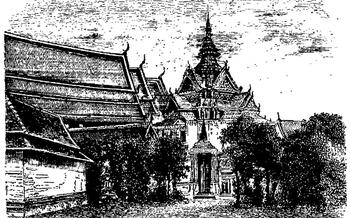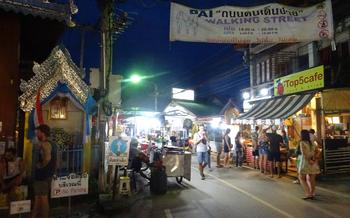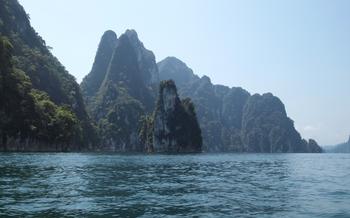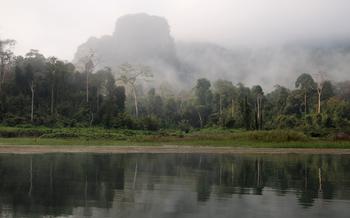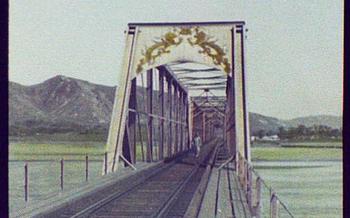
World War II Memorial Bridge in Pai
- History of the Bridge
- Location
- Reconstruction and Preservation
- Symbol of Resilience
- Pai River and Natural Surroundings
- Walking and Cycling
- Tourist Attraction
- Historical Tours and Guides
- Local Markets and Handicrafts
- Accommodation and Dining Options
- Transportation
- Pai's Nightlife
- Other Attractions in Pai
- A Serendipitous Discovery:
History of the Bridge
During World War II, the Japanese troops sought to expand their presence in Southeast Asia and occupied Thailand in 194As part of their strategic military operations, they aimed to construct a bridge across the Pai River to facilitate the transportation of troops and supplies towards Burma (present-day Myanmar). The bridge held immense strategic significance as it provided a crucial land route for the movement of troops and resources. The Japanese engineers employed local labor to construct the bridge, utilizing locally sourced materials such as wood and bamboo. The bridge's design reflected the urgency of the Japanese military's need to establish a swift connection across the river, emphasizing functionality over aesthetics.
Location
Nestled amidst the picturesque landscapes of Pai, Mae Hong Son, the World War II Memorial Bridge stands as a poignant reminder of the region's turbulent past. Situated just a short distance from the city center, the bridge is easily accessible by road, inviting visitors to embark on a journey through time. The GPS coordinates for the bridge are 1351389, 9443889, allowing for seamless navigation to this historical landmark.
Reconstruction and Preservation
In the aftermath of World War II, the World War II Memorial Bridge in Pai, Mae Hong Son underwent a meticulous reconstruction process to restore its former glory. The bridge, which had suffered significant damage during the conflict, required extensive repairs and renovations to ensure its structural integrity and historical authenticity. Engineers and architects carefully assessed the damage and utilized traditional techniques to maintain the bridge's original design and appearance as much as possible.
Rebuilding the bridge posed several challenges, including sourcing materials that matched the original construction and adhering to strict preservation guidelines. Local craftsmen and artisans played a crucial role in replicating intricate details and decorative elements, ensuring that the bridge retained its unique character.
Ongoing maintenance and conservation measures are essential to preserving the historical integrity of the bridge. Regular inspections and repairs help prevent further deterioration and address any potential issues before they escalate. The local community and authorities work together to safeguard the bridge, ensuring that it remains a symbol of resilience and a testament to the enduring spirit of the people of Pai.
Symbol of Resilience
The World War II Memorial Bridge in Pai stands as a powerful symbol of resilience and determination in the face of adversity. During the war, the bridge played a crucial role as a strategic passage for Japanese troops, but its destruction left an enduring mark on the local community. The resilient spirit of the people of Pai shone through as they worked tirelessly to rebuild the bridge after the war, restoring it to its former glory. Today, the bridge serves as a reminder of the hardships endured during wartime and the unwavering resolve of the local population to overcome challenges and rebuild their lives. Its status as a historical landmark further solidifies its significance, honoring the memory of those who fought and sacrificed during the war.
Pai River and Natural Surroundings
The World War II Memorial Bridge in Pai is not just a historical landmark but also a gateway to the breathtaking natural beauty of the surrounding area. The bridge spans the picturesque Pai River, which meanders through lush green valleys and is surrounded by towering mountains. The stunning views from the bridge are a feast for the eyes, and the serene atmosphere makes it an ideal spot for relaxation and contemplation.
As you cross the bridge, take a moment to admire the crystal-clear waters of the river, which reflect the vibrant colors of the surrounding foliage. The riverbanks are home to a variety of plant and animal life, including exotic birds, butterflies, and wildflowers. The lush greenery that envelops the area creates a tranquil ambiance, making it a perfect place to escape the hustle and bustle of city life.
Whether you're an avid photographer or simply someone who appreciates the beauty of nature, the Pai River and its surroundings offer ample opportunities to capture stunning images. The bridge itself, with its unique architecture and historical significance, serves as a striking centerpiece against the backdrop of the natural landscape. So, don't forget your camera when visiting this hidden gem in Pai.
Walking and Cycling
The World War II Memorial Bridge in Pai is not just a historical landmark but also a popular spot for walking and cycling. Designated pathways and trails have been created for pedestrians and cyclists, making it easy and safe to explore the area on foot or by bike. Take a leisurely stroll along the bridge, admiring the stunning views of the Pai River and the surrounding mountains. Enjoy the fresh air and scenic landscapes as you immerse yourself in the tranquility of nature. For those who prefer a more active experience, cycling is a great way to explore the bridge and its surroundings. With designated bike lanes and relatively flat terrain, it's a perfect place for a leisurely ride. Whether you're a seasoned cyclist or a beginner, the World War II Memorial Bridge offers a unique and enjoyable experience for all.
Tourist Attraction
In recent years, the World War II Memorial Bridge has emerged as a significant tourist attraction in Pai, drawing visitors from around the world. Its historical significance, coupled with its scenic surroundings, has made it a popular destination for both history buffs and nature enthusiasts. The bridge's unique architecture and resilience have captured the imagination of travelers, who flock to see this symbol of perseverance and determination.
As word of the bridge's beauty and historical importance spread, it has gained recognition as a must-visit destination in Pai. Visitors can stroll or cycle across the bridge, taking in the stunning views of the Pai River and the lush green mountains that envelop it. The bridge serves as a picturesque backdrop for photographs, allowing visitors to capture the essence of this remarkable site.
The growing popularity of the bridge has contributed to the local tourism industry, providing economic opportunities for the people of Pai. Souvenir shops and local markets have sprung up near the bridge, offering visitors a chance to purchase unique handicrafts and support local artisans. This influx of tourism has also led to the development of restaurants, cafes, and accommodation options catering to the needs of visitors.
Historical Tours and Guides
Enhancing the experience of visiting the World War II Memorial Bridge in Pai is the availability of guided tours that provide valuable historical insights into the site. These tours are led by local guides who possess a wealth of knowledge about the bridge's construction, its significance during the war, and the stories of the people who lived through that tumultuous period.
As you embark on a guided tour, you'll be transported back in time, learning about the strategic importance of the bridge during World War II and the role it played in the Japanese occupation of Thailand. You'll hear anecdotes and stories of the local people, their resilience in the face of adversity, and their determination to rebuild their lives after the war.
These guided tours offer a deeper understanding of the historical significance of the bridge, allowing visitors to connect with the past and appreciate the enduring spirit of the local community. Whether you're a history buff or simply seeking a more immersive experience, these tours are an excellent way to gain a comprehensive understanding of the World War II Memorial Bridge and its place in Thailand's history.
Local Markets and Handicrafts
In the vicinity of the World War II Memorial Bridge in Pai, visitors can immerse themselves in the vibrant local markets and shops that showcase the exquisite craftsmanship of the region. These markets offer a treasure trove of handmade souvenirs and handicrafts, providing an opportunity to support local artisans while taking home unique mementos of your travels. From intricate woven textiles and hand-carved wooden sculptures to colorful ceramics and silver jewelry, there is something to suit every taste and budget. By purchasing these handcrafted items, you not only contribute to the local economy but also promote sustainable tourism practices that empower local communities.
Accommodation and Dining Options
Pai offers a wide range of accommodation options to suit every budget and preference. From budget hostels and guesthouses to mid-range hotels and luxurious resorts, there's something for everyone. Hostels and guesthouses are a great option for budget-conscious travelers, offering basic but comfortable rooms at affordable prices. For a more comfortable stay, choose from the many hotels in Pai, which offer a range of amenities such as private bathrooms, air conditioning, and swimming pools. If you're looking for a truly indulgent experience, consider staying at one of Pai's luxury resorts, which offer stunning views, world-class amenities, and personalized service.
When it comes to dining, Pai has something to offer everyone, from traditional Thai cuisine to international fare. For a taste of authentic Thai food, head to one of the many local restaurants, where you can sample delicious dishes such as khao soi, pad thai, and som tam. If you're looking for something different, there are plenty of international restaurants to choose from, serving everything from Italian and Mexican to Indian and Japanese cuisine. Be sure to try the local specialty, Pai Walking Street, which is a lively night market with a wide variety of food stalls and vendors.
For those looking for a more affordable dining experience, there are many street food stalls and markets where you can find delicious and authentic Thai food at a fraction of the price of a restaurant meal. Be sure to try the khao niao mamuang, a popular Thai dessert made with sticky rice and mango.
No matter what your budget or preferences, you're sure to find something to your taste in Pai. With its wide range of accommodation and dining options, Pai is the perfect place to relax and enjoy your vacation.
Transportation
Reaching Pai is a breeze, with multiple transportation options available from major cities in Thailand. For a budget-friendly adventure, hop on a public bus or van that departs from Bangkok, Chiang Mai, or other nearby cities. These buses offer a comfortable and affordable journey, allowing you to sit back and enjoy the scenic landscapes along the way.
If you prefer a more independent mode of travel, renting a car or motorcycle is a great option. This gives you the freedom to explore Pai and its surroundings at your own pace, stopping at hidden gems and viewpoints along the way. Just remember to drive cautiously and obey traffic regulations to ensure a safe and enjoyable road trip.
Once in Pai, you'll find it easy to get around on foot or by bicycle. The town is relatively compact, and many attractions, including the bridge, are within walking distance. Cycling is another popular option, as it allows you to explore the town's charming streets and countryside trails at a leisurely pace. Several bike rental shops are available, offering a range of bicycles to suit your needs and budget.
Pai's Nightlife
In addition to its historical and natural attractions, Pai boasts a vibrant nightlife scene, making it a popular destination for both backpackers and thrill-seekers. As the sun sets, the town transforms into a lively hub of activity, with a diverse range of bars, clubs, and live music venues catering to every taste.
For those seeking a relaxed atmosphere, cozy bars offer a haven to unwind with a drink and enjoy the company of fellow travelers. Craft beer enthusiasts can indulge in locally brewed beers at the many microbreweries, while cocktail aficionados can savor expertly mixed drinks at stylish cocktail bars.
For those looking to dance the night away, Pai's clubs offer an energetic ambiance, with DJs spinning the latest tunes to keep the crowd moving. Live music venues provide a platform for talented musicians to showcase their skills, with genres ranging from rock and reggae to traditional Thai music.
Safety is a priority in Pai, and visitors can enjoy the nightlife without any major concerns. However, it's always advisable to be vigilant and take precautions, such as avoiding walking alone at night and being mindful of drink consumption.
To make the most of Pai's nightlife, plan your evenings to catch multiple venues and events. Start with a pre-dinner drink at a bar, then head to a restaurant for a delicious meal. Afterward, explore the live music scene or dance the night away at a club. With its vibrant atmosphere and diverse offerings, Pai's nightlife promises an unforgettable experience for all visitors.
Other Attractions in Pai
While the World War II Memorial Bridge is a must-visit attraction in Pai, the town offers a wealth of other experiences for travelers. The Pai Canyon, with its stunning red rock formations and panoramic views, is a popular spot for hiking and photography. The Tham Lod Cave, with its impressive stalactites and stalagmites, offers a fascinating glimpse into the underground world. And the Wat Phra That Mae Yen Temple, perched atop a hill overlooking the town, is a beautiful example of Lanna architecture and a sacred site for local Buddhists.
To make the most of your time in Pai, consider creating a comprehensive itinerary that allows you to explore these diverse attractions. For a well-rounded experience, plan to spend at least two or three days in town. This will give you ample time to visit the bridge, hike the canyon, explore the cave, and visit the temple, as well as relax and soak up the unique atmosphere of Pai.
When planning your itinerary, consider your interests and time constraints. If you're short on time, prioritize the attractions that are most important to you. If you have more time, take the opportunity to explore beyond the main tourist spots and discover the hidden gems of Pai.
Also, keep in mind that Pai is a relatively small town, so it's easy to get around on foot or by bicycle. This makes it easy to combine multiple attractions in a single day. For example, you could start your day with a visit to the bridge, followed by a hike in the canyon, and then end the day with a sunset visit to the temple.
No matter how you choose to spend your time in Pai, be sure to take advantage of the town's many offerings. From its natural beauty to its cultural attractions, Pai has something to offer every traveler.
A Serendipitous Discovery:
As I strolled along the riverbank, my eyes caught a glimpse of a hidden staircase carved into the rocks. Curiosity sparked within me, and I decided to follow the path. To my surprise, it led me to a secluded viewpoint overlooking the bridge and the Pai River. The panoramic vista was breathtaking, with lush green mountains stretching out into the distance. The tranquility of the moment was palpable, and I couldn't help but feel a sense of serenity wash over me.
This unexpected discovery was a reminder that Pai is a place where hidden gems await those who venture off the beaten path. Whether it's a secluded viewpoint, a charming local eatery, or a hidden waterfall, there's always something new to explore in this enchanting town. So, dear travelers, embrace your curiosity and allow yourself to be surprised by the hidden treasures that Pai has to offer.
